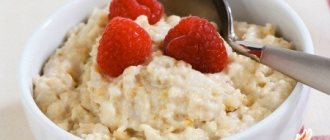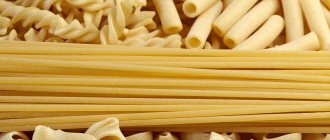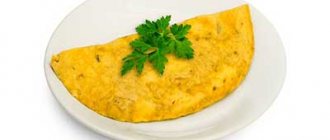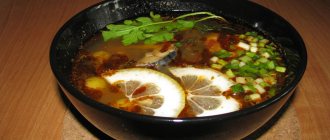In bodybuilding, good nutrition is a prerequisite for gaining muscle mass. The problem with most beginners is their absolute ignorance of how much food they need to grow muscles. People are used to grabbing a sandwich with sausage for breakfast, and when they replace it with porridge, they already think that they have improved their nutrition.
It is known that for muscle growth you need to consume at least 5 grams
carbohydrates per 1 kg of body weight. In addition, 2-3 grams of protein and approximately 0.5 grams of fat (unsaturated) - again per 1 kg of weight.
Using a tablespoon
Surely it won’t be difficult to find a tablespoon in the kitchen. Therefore, if you need to weigh out 100 grams of flour, arm yourself with this device.
A heaped tablespoon contains 15 grams of flour.
. Therefore, to measure the amount required for the recipe, you will have to scoop with a spoon almost 7 times.
If you fill a level tablespoon, the volume will be 10 grams. Simple mathematical calculations allow you to understand that in order to maintain the proportions indicated in the recipe, you will need to take 10 spoons.
How much is 100 grams of boiled buckwheat porridge?
You should already understand that the mass of dry buckwheat groats exceeds the volumetric mass of water. Therefore, the volumetric mass of cooked porridge is higher than that of water and lower than that of dry cereal. This is approximately 1.08 ml/g (milliliters per gram). Taking this into account, 100 grams of boiled buckwheat:
- The volume occupied by the product is 108 milliliters, which is a little more than half a glass.
- This is a little more than 4 tablespoons. You can take heaping spoonfuls to get the required volume - 100 grams of boiled cereal.
Please note that the calorie content of buckwheat is 308 kcal, and the nutritional value of the product is:
- 12.6 g – proteins;
- 3.3 g – fats;
- 57.1 g – carbohydrates.
There is no need to talk much about the benefits of buckwheat; everyone already knows about its properties and qualities. Therefore, be sure to include this product in your weekly diet to feel better, more energetic, and healthier.
We tried to figure out some measurement methods to make it easier for you to understand how much 100 grams of buckwheat is. We hope this information will be useful to you and will definitely come in handy when preparing a variety of dishes from buckwheat - so popular, healthy, medicinal and dietary.

Meat serving size
Meat: palm of hand
The portion of meat should be the size of the palm of your hand (not including fingers).
The steak in the photo weighs approximately 100 grams and is about the thickness of a deck of cards. A portion of this size of protein can be taken with every meal, and you need to spread your protein intake throughout the day, as we process it better in small portions. However, you should not consume more than 500 grams of red meat per week, and it is better to choose other sources of protein, such as fish and legumes.
How much is the volume of one hundred grams of buckwheat?
When calculating this value, you should first understand the parameters of density and volumetric mass. Dry buckwheat will have a density of 800 g/l (grams per liter), which means that only 800 grams of product will fit into a liter jar (level with the top of the jar). In this case, the volumetric mass is 1.250 l/kg (liters per kilogram), that is, 1 kilogram of buckwheat will not fit in a liter jar, since it takes up more - 1.250 containers. Considering the features described above, remember that the answer to the question of how much 100 grams of buckwheat is is simple. One hundred grams of buckwheat occupies a volume of 125 milliliters.

Fish portion
White fish: whole hand
White fish such as cod, haddock or pollock are low in fat and calories, so a serving can be as large as your hand (about 150 grams and 100 calories).
White fish contains small amounts of omega-3 and is a good source of selenium, important for the immune system, healthy hair and nails.
Oily fish: palm
Like meat, a portion of fatty fish such as salmon, mackerel or sardines should be about the size of your palm. Fatty fish fillets weigh about 100 grams and contain about 200 calories. One serving per week will provide you with enough omega-3 fatty acids.
Contraindications
Large and frequent consumption of buckwheat is contraindicated for gastritis and ulcers, as well as during pregnancy and breastfeeding. In addition, there is individual intolerance to the product.
The buckwheat diet, based on the consumption of only buckwheat, has a number of contraindications that you should familiarize yourself with in advance.

Did you know?
- It is believed that buckwheat consumption affects good mood.
- In India and China, cereals are used not only for food, but also as an influence on various biological points: they simply pour it on the carpet and walk.
- Greek cereal helps with insomnia.
- Buckwheat is part of Japanese culture.
- Buckwheat is a very low-yielding cereal, so it is rarely found in Europe.
- Buckwheat porridge contains a high dose of protein.
- Despite its considerable calorie content, buckwheat helps in weight loss by accelerating metabolism.
- Cereals prevent cirrhosis.
- If sugar gets into buckwheat porridge, it neutralizes everything beneficial.
- Buckwheat, sorted and fried yourself, tastes better than packaged buckwheat.
Watch the video below about the properties of buckwheat.
2 years ago
Today, buckwheat is one of the most popular cereals, not only in Russia and neighboring countries, but throughout the world! Buckwheat is so healthy that it is recommended for children to consume it as often as possible. However, in order to cook buckwheat deliciously according to the recipe, you must first measure out the required amount with a spoon. So, how many grams are in a tablespoon of dry buckwheat and how many grams are ready?
A serving of pasta per day
Pasta: clenched fist
This amount of pasta seems quite small, but the pasta will expand in size as it cooks. This serving contains 75 grams and 219 calories. A serving of uncooked rice should also be the size of your fist.
Carbohydrates, which are important for maintaining energy, and fiber should take up a quarter of your plate (proteins the other quarter and vegetables half the plate).
The sauce will add extra calories.
About the cereal
Buckwheat is considered one of the indispensable products on our table. This grain is used to start complementary feeding for babies, it is boiled for the Lenten table, in practice there are entire “buckwheat diets”. In V.V. Pokhlebkin’s book “The History of the Most Important Food Products,” buckwheat is called “a symbol of Russian originality.”
This crop was brought to Russia from Greece. Hence its consonant name - buckwheat, in other words, Greek cereal.
Buckwheat is not a cereal crop; it belongs to the family of herbaceous plants. From plants of the buckwheat family, kernels (whole grain and prodel), Smolensk groats and buckwheat flour are extracted.
Buckwheat is a component for the production of various drugs used in medicine; The husks and shells of the seed are suitable for stuffing medicinal pillows. The culture is suitable for food not only for humans, but also for animals and birds.
Food servings per day
Butter: tip of thumb
Any serving of fats, including butter, vegetable oil, and peanut butter, should be no larger than a teaspoon or the size of the tip of your thumb from knuckle to nail tip. In total, there should be no more than 2-3 servings of fat per day.
Chocolate: index finger
A piece of chocolate the size of your index finger (20 grams) contains approximately 100 calories and is an adequate treat.
Cheese: two fingers
A 30 gram portion of cheese should be the length and depth of two fingers. It contains about 125 calories and provides you with a third of the recommended dose of calcium. A serving of grated cheese can be the size of your fist.
Cake: two fingers
The cake slice should be the length and width of two fingers (one end may be a little wider if you cut with a wedge). This serving contains about 185 calories and is acceptable as a treat.
Calorie content of pasta (dry):
~ 340 kcal,
boiled:
~ 175 kcal* * average value per 100 g, depends on the type of flour, type of pasta and cooking methods
Pasta is a popular dish characterized by its nutritional value and high energy value. Different types - spaghetti, noodles, pasta - are used to prepare casseroles, soups and cold appetizers.
Why do you need to know the volume?
For people who care about their nutrition, it is important to know the energy value and calorie content of ready-made cereal dishes. Buckwheat in a dry and processed state has different weights and volumes. When cooked, it becomes heavier, therefore, the volume increases. First, you need to sort the grains, and then, if the seeds are light, fry them in a frying pan without oil.
In order not to make a mistake with the recipe for a new dish or to have an idea of how much your baby needs for complementary feeding, you need to know the required weight of the food product. All recipes indicate the required amount of cereal in grams. If you have a kitchen scale or even an electric floor scale at hand, finding out the number of grams will not be a problem. But what if there is nothing at hand? Then various tables from cookbooks come to the rescue, where everything is already measured and calculated. But what to do if there is no such book nearby? Here, by the way, the housewife’s knowledge of the volume of various products will come in handy.
How many calories are in 100 grams of pasta?
Pasta is not only tasty, but also a healthy product. Due to the content of vitamin B in products made from durum wheat, a person feels a surge of strength and energy for a long time. Amino acids help normalize sleep and mood, and fiber helps remove all harmful substances from the body and restores intestinal function.
The Italian product differs from the domestic one in composition. In the first case, only flour and water are used, in the second, eggs and butter are added.
Flour for making pasta can be of baking, hard, or glassy varieties. The first option is considered more beneficial for the body. Depending on the type, the calorie content of the product (dry) is 320-360 kcal. About the same numbers for or.
For your diet, it is better to choose products made from rice or buckwheat flour.
The products of the well-known brand “Makfa” (only durum wheat is used) have 345 kcal, the products do not become overcooked and keep their shape. Barilla has a higher figure - 360 kcal. Spaghetti, bows, lasagna sheets, feathers are distinguished by their excellent taste and high quality. Manufacturers can add tomatoes, spinach, carrots, spices and herbs to create beautiful and more savory pasta.
Useful components of buckwheat
Buckwheat contains the following set of vitamins:
- B vitamins necessary to maintain the cardiovascular system;
- PP (nicotinic acid) helps regulate blood sugar and reduce cholesterol;
- E prevents the formation of blood clots, acts as an antioxidant, promotes a beautiful complexion;
- K prevents age-related changes, promotes tissue regeneration.
Buckwheat consists of a large number of microelements.
Cereals are especially rich in iron, so buckwheat porridge is indicated for dietary nutrition for people suffering from anemia.
Potassium (another element of buckwheat) helps improve the functioning of the heart and blood vessels, lower blood pressure, eliminate dizziness and the formation of blood clots.
Buckwheat contains proteins that are easily digested and carbohydrates that are broken down slowly. 100 grams of buckwheat porridge contains only 132 kcal. This is an excellent dish for overweight people.
Such excellent nutritional characteristics may make you want to eat only buckwheat.
Calorie content of boiled and fried pasta
The energy value of pasta depends not only on its type, but also on the products that are added during the cooking process. When cooking, the numbers decrease by more than 2 times (about 120 kcal per 100 grams). This is due to the increase in volume of products after boiling.
One standard serving of boiled pasta (150 g) contains 180 kcal.
Additives (butter, sauces, cheese, sour cream) significantly change the value of the finished dish. For boiled products with butter (2 tablespoons), the indicator will be almost 180 kcal per 100 g. Read about the properties and calorie content of butter.
Nutritionists advise replacing animal oil with vegetable oil. In the homeland of pasta, olive oil is used; when it is added, the energy value is reduced by 20 units (160 kcal). Get to know us in our article. If you want to fry pasta in oil, you should pay attention to the high calorie content of the finished dish - more than 190 kcal.
How to use
Eating buckwheat for weight loss will not bring the desired result if you combine it with certain foods:
- fat meat;
- sugar;
- smoked meats;
- sauces, mayonnaise;
- oil in large quantities.
It is advisable to eat any buckwheat dishes in the first half of the day. It is not forbidden to eat them in the evening, but no later than 18:00. You cannot eat buckwheat at night, as the product takes 1.5-2 hours to digest, which will not allow the digestive system to fully rest.
For fasting days, it is recommended not to cook the cereal, but to soak it. Then it retains more vitamins and microelements. To do this, you will need 200 ml of boiling water for 1 glass: steam it in a thermos in the evening and leave it overnight. In the morning, drain off the remaining liquid. There is no need to add salt or add anything. Divide the resulting dish into 5-6 servings and eat throughout the day.
If the bland taste of the porridge is unbearable, then you can add a little chopped herbs, kelp (seaweed) or a spoonful of honey.
With daily mental stress, such a poor diet can provoke increased cravings for sweets. Then you should mix porridge with dried fruits for breakfast, and drink a glass of honey water on an empty stomach every morning.
You can’t eat buckwheat alone for a long time, maximum 5–7 days. Otherwise, the body begins to lack minerals and other nutritional components. Therefore, they additionally eat fresh fruits and vegetables, eggs, sea fish, white meat and drink a lot. The result of losing weight in this way depends not only on the amount eaten, but also on optimal physical activity.
The buckwheat diet is indicated not only for weight adjustment, but also in case of certain health problems. Cereals can be eaten in any form: boiled, steamed, soaked in kefir, baked. The menu for the day is varied, but within acceptable limits regarding the food set.
The advantage of such a diet is that buckwheat is allowed to be eaten in unlimited, but reasonable quantities. Because of this, those losing weight do not experience discomfort throughout the entire restrictive period. There is no need to count calories every day. In a week you can lose 7-8 kilograms while maintaining muscle mass.
The essence of the buckwheat diet:
- Eat 4-5 times in small portions. To avoid overeating, it is recommended to replace your usual plates with smaller ones, with a volume of 200–250 g.
- Drink up to 2 liters of water per day.
- Exclude from the diet foods and unhealthy drinks that are not included in the menu: store-bought juices, sweet soda, alcohol.
- Minimize salt intake.
- Stop eating 3 hours before bedtime.
Additional drinks: kefir (1% fat), still mineral water, green tea and herbal infusions. If you have an increased craving for sweets, then drink honey water: 1 tsp per glass. Suitable snacks include: green apples, oranges, grapefruit. You can eat no more than one fruit per day.
For the first 2–3 days, the basic dish is raw buckwheat porridge, then it is allowed to include various dietary recipes from cereals. Usually this regime is followed for a week, but if you are comfortable, it can be longer.
Options for light short-term buckwheat diets:
- Kefir. A fermented milk product is added to the classic version at the rate of 1 liter per day. They wash it down with porridge or put it directly into it.
- With fruits and vegetables. Any fruit except grapes, bananas, dates is mixed or eaten whole. Additionally include fresh or steamed non-starchy vegetables.
- Strengthening. The most varied nutritional option, where in addition to buckwheat it is acceptable to eat something else: cottage cheese for breakfast, veal and vegetable salad for lunch. Portions on this diet are larger, but the number of meals is reduced to 3.
If you eat only buckwheat, without salt and oil, then excess weight will go away very quickly. However, this is an emergency measure that will not bring health benefits.
Calorie content of pasta dishes
If you boil pasta and add cheese to it, you will get a fairly high-calorie dish (330 kcal) that is not suitable for dietary nutrition. You can reduce the indicator if you use low-fat varieties of dairy product in an amount of no more than 1 tablespoon. You can read about it in our publication.
Popular dishes where pasta is the main ingredient:
- baked with egg – 152 kcal;
- with beef stew – 190 kcal;
- with minced meat (navy style) – 230 kcal;
- with pieces of beef – 215 kcal;
- noodle soup – 90 kcal;
- with chicken breast – 290 kcal;
- with Bolognese sauce – 200 kcal.
The most dietary option is durum spaghetti with the addition of vegetables or seafood. The value of such a dish will be only 110-120 kcal.
The quality of the paste, beneficial properties, and energy value depend on the varieties of cereal crops used and manufacturing technologies. During the diet, you should limit consumption to one small serving every 2-3 days.
A little history
The cereal is native to the Himalayas, where wild species are still found. In the seventh century, Greek monks began to grow buckwheat. They brought the grain to Kievan Rus, where they began to call it buckwheat. Gradually they began to grow it in the Volga region, Ukraine, and Altai.
The Greeks and Italians themselves called it Turkish grain. In France, Portugal, and Spain, the cereal was called Saracen or Arab grain. Western Slavs (Czechs, Slovaks) call buckwheat toadstool. In England and America, buckwheat is called deer wheat, in Asia - black rice.
Buckwheat is known to many peoples of the world. In Korea, traditional holiday buns are made from it, in China - liqueur, chocolate, and jam. In France, buckwheat is specially grown for the bees to collect buckwheat honey, which is very good for the prevention and treatment of colds and flu.
No matter what buckwheat is called, no matter what dishes are prepared from it, in terms of its beneficial properties it is truly the queen of cereals.
Using buckwheat in dietary nutrition, many people wonder why it is so beneficial. How many grams are in a tablespoon of boiled buckwheat? Will the calorie content of dishes made from it harm your waistline?








